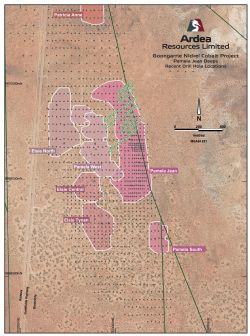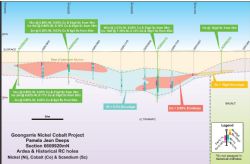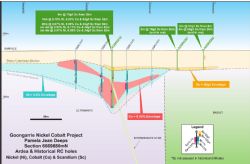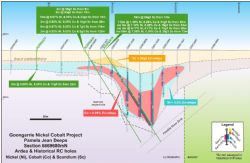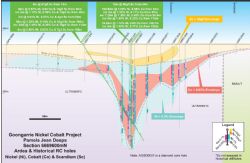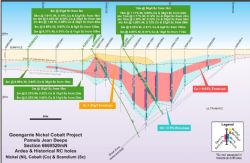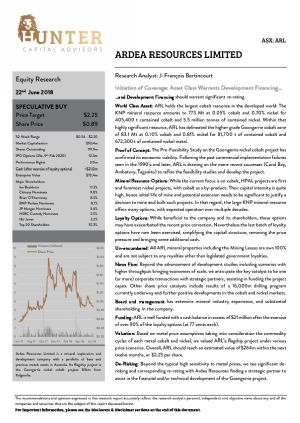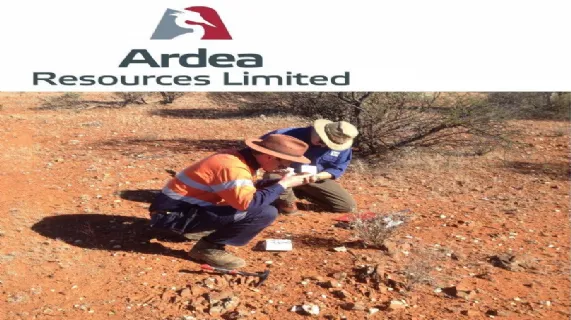
High-Grade Nickel-Cobalt Mineralization Extended at Goongarrie
Perth, Oct 8, 2018 AEST (ABN Newswire) - Ardea Resources Ltd ( ASX:ARL) (
ASX:ARL) ( ARRRF:OTCMKTS) announces Recent drilling results from the Pamela Jean Deeps confirm and extend the deeper high-grade mineralization. This zone is scheduled as the mining target during the payback period, to enhance project economics.
ARRRF:OTCMKTS) announces Recent drilling results from the Pamela Jean Deeps confirm and extend the deeper high-grade mineralization. This zone is scheduled as the mining target during the payback period, to enhance project economics.
- Ongoing Definitive Feasibility Study (DFS) drilling program confirms high-grade intercepts at the Pamela Jean Deeps orebody.
o AGSR419 112m at 1.30% Ni, 0.26% Co, 31g/t Sc from 30m(see Note 1 below)
o AGSD0001 100.8m at 1.00% Ni, 0.08% Co from 32m(see Note 2 below)
o AGSR0413 76m at 1.11% Ni, 0.09% Co and 38g/t Sc from 24m
o AGSR0418 56m at 1.29% Ni, 0.14% Co and 18g/t Sc 104m
o AGSR0190 57m at 1.04% Ni, 0.10% Co and 21g/t Sc from 70m
- The top of Pamela Jean is a typical flat laterite surface at 15-30m below surface. Rather than a flat base some 40-50m below surface, the base of Pamela Jean is "funnel-shaped", penetrating up to 165m below surface. With continuous mineralisation to depth, this geometry fortuitously mimics pit design batters, minimizing Pamela Jean strip ratios. The result is high tonnes and grade proximal to future plant site.
- The "deep funnel" ore is associated with a narrow dyke and intense shearing that has facilitated exceptionally deep weathering (to 165m).
- An additional "funnel-shaped" Deeps ore zone discovered in 20m infill drilling (AGSR0190), suggests potential for further deeper high-grade ore, associated with bedrock structures, still requiring drill appraisal.
- Uniform goethite mineralization confirmed at Pamela Jean, validates Pamela Jean as a premium autoclave feed for project payback.
- Ore geometry very consistent, with >0.5% Ni pervasive between the base of lateritized alluvium overburden and top of carbonated saprock basement, facilitates predictable mine planning, free-dig ore until mining encounters sub-grade hard saprock at the pit base and within batters, excellent visual grade control.
- Ardea inclined drill-holes have precisely confirmed historic drill results, serves as a QAQC program for historic work.
- Scandium mineralization evident from surface, typically 30-62g/t Sc when occurring in the nickel-cobalt ore feed.
- Magnesite neutralizer pervasive within ore footwall, ~0.5% Ni credit.
Recent drilling results from the Goongarrie orebody
Pamela Jean Deeps
Significant intercepts from the Pamela Jean Deeps drilling(see Note 3 below)
6669440mN section
AGSR0412 38m at 0.89% nickel, 0.06% cobalt and 36g/t scandium from 22m(see Note 4 below)
including 8m at 1.16% nickel, 0.13% cobalt and 34g/t scandium from 30m
AGSR0412 14m at 0.78% nickel, 0.04% cobalt and 8g/t scandium from 136m(see Note 4 below)
including 2m at 1.13% nickel, 0.11% cobalt and 6g/t scandium from 140m
AGSR0411 32m at 0.84% nickel, 0.05% cobalt and 15g/t scandium from 22m(see Note 4 below)
including 2m at 1.28% nickel, 0.09% cobalt and 22g/t scandium from 38m
AGSR0411 20m at 0.71% nickel, 0.03% cobalt and 9g/t scandium from 76m(see Note 4 below)
6669520mN section
AGSR0414 4m at 0.44% nickel, 0.54% cobalt and 52g/t scandium from 14m(see Note 4 below)
AGSR0414 38m at 1.01% nickel, 0.10% cobalt and 43g/t scandium from 16m(see Note 4 below)
including 8m at 1.40% nickel, 0.08% cobalt and 30g/t scandium from 40m
AGSR0413 76m at 1.11% nickel, 0.09% cobalt and 38g/t scandium from 24m(see Note 4 below)
including 12m at 1.11% nickel, 0.12% cobalt and 36g/t scandium from 44m
including 16m at 1.36% nickel, 0.22% cobalt and 35g/t scandium from 66m
including 4m at 1.36% nickel, 0.13% cobalt and 33g/t scandium from 88m
6669600mN section
AGSR0418 42m at 0.67% nickel, 0.04% cobalt and 14g/t scandium from 30m(see Note 4 below)
including 2m at 1.12% nickel, 0.09% cobalt and 13g/t scandium from 48m
AGSR0418 56m at 1.29% nickel, 0.14% cobalt and 18g/t scandium from 104m(see Note 4 below)
including 36m at 1.40% nickel, 0.20% cobalt and 19g/t scandium from 110m
AGSD0001 100.8m at 1.00% nickel, 0.08% cobalt from 34m(see Note 4 below)
including 2m at 1.02% nickel, 0.11% cobalt from 87m
including 7.2m at 1.30% nickel, 0.45% cobalt from 95.6m
including 6m at 1.40% nickel, 0.22% cobalt from 118m
AGSD0001 24.8m at 1.10% nickel, 0.08% cobalt from 140.2m(see Note 4 below)
including 8m at 1.40% nickel, 0.11% cobalt from 152m
6669680mN section
AGSR0419 112m at 1.30% nickel, 0.26% cobalt and 31g/t scandium from 30m(see Note 4 below)
including 6m at 1.14% nickel, 0.08% cobalt and 19g/t scandium from 42m
including 68m at 1.58% nickel, 0.39% cobalt and 35g/t scandium from 72m
6669760mN section
AGSR0422 48m at 0.94% nickel, 0.07% cobalt and 19g/t scandium from 104m(see Note 4 below)
including 8m at 0.88% nickel, 0.16% cobalt and 18g/t scandium from 114m
including 4m at 1.48% nickel, 0.09% cobalt and 135g/t scandium from 134m
AGSR0421 26m at 0.66% nickel, 0.04% cobalt and 35g/t scandium from 20m(see Note 4 below)
AGSR0421 76m at 0.82% nickel, 0.07% cobalt and 28g/t scandium from 54m(see Note 4 below)
including 28m at 0.91% nickel, 0.14% cobalt and 27g/t scandium from 84m
AGSR0190 24m at 0.86% nickel, 0.02% cobalt and 99g/t scandium from 36m4
AGSR0190 57m at 1.04% nickel, 0.10% cobalt and 21g/t scandium from 70m
including 14m at 0.82% nickel, 0.20% cobalt and 24g/t scandium from 70m
including 16m at 1.28% nickel, 0.10% cobalt and 29g/t scandium from 90m
6669840mN section
AGSR0186 62m at 0.92% nickel, 0.04% cobalt and 32g/t scandium from 22m(see Note 4 below)
including 2m at 1.40% nickel, 0.08% cobalt and 50g/t scandium from 66m
AGSR0417 26m at 0.90% nickel, 0.04% cobalt and 29g/t scandium from 22m(see Note 4 below)
AGSR0187 60m at 1.14% nickel, 0.08% cobalt and 47g/t scandium from 24m(see Note 4 below)
including 24m at 1.27% nickel, 0.14% cobalt and 33g/t scandium from 60m
6669880mN section
AGSR0416 28m at 0.87% nickel, 0.08% cobalt and 34g/t scandium from 62m(see Note 4 below)
including 4m at 0.83% nickel, 0.11% cobalt and 34g/t scandium from 62m
including 8m at 0.91% nickel, 0.09% cobalt and 34g/t scandium from 82m
6669920mN section
AGSR0294 18m at 0.98% nickel, 0.08% cobalt and 34g/t scandium from 18m(see Note 4 below)
including 8m at 0.98% nickel, 0.12% cobalt and 43g/t scandium from 18m
AGSR0415 46m at 1.03% nickel, 0.06% cobalt and 35g/t scandium from 28m(see Note 4 below)
including 10m at 1.33% nickel, 0.14% cobalt and 34g/t scandium from 46m
Pamela Jean Geological Model
The current Pamela Jean Deeps drilling was initially executed as a precursor to a geotechnical program, but has generated new insights into Goongarrie geological models, geo-metallurgy and geotechnics.
The 2018 Ardea drilling at Goongarrie, and Pamela Jean in particular, is restricted to 80x40m infill of proposed pit locations where existing 80x80m drill patterns define the current Indicated Mineral Resource (refer ASX announcement 14 March 2018 for current resource statement). Being infill drilling during 2018, changes to the overall Mineral Resources are expected to be non-material. Of note, historical geological interpretations for the run-of-mine "shallow flat" lateritic mineralization have been precisely confirmed by 2018 drilling, suggesting robust QAQC for historic Goongarrie drilling.
The recent Pamela Jean Deeps drilling has been different to earlier 2018 drilling, in that the inclined holes (first time executed anywhere at Goongarrie) have quantified deep "funnel-shaped" ore zones, especially in respect to structural controls on deep ore. Importantly, "deep funnel" mineralization has been defined (notably by drill-hole AGSR0190 section 6669760mN) where previous drilling only had "shallow flat" ore.
Historic hole GSRC0184 (323096mE) returned 22m at 0.58% Ni and 0.03% Co from 17m and GSRC1005 (323140mE) returned 35m at 0.82% Ni and 0.11% Co from 28m. Ardea RC drill-hole AGSR0190 (323116mE) between the two returned 91m at 0.92% Ni and 0.07% Co from 36m (stops in ore), and in addition intersected a previously unrecognized dyke dipping 650 east that fingerprints the "deep funnel".
Following this result, a systematic drill data review was completed, identifying a significant number of holes stopping in ore where potential deep "funnels" could be present (as for AGSR0190). This will necessitate amendments to wireframes and ultimately pit designs. With the deepening and widening of potential pits, various geotechnical parameters in terms of batter designs and PAL plant neutralizer also come into play.
As 2018 RC drilling winds down, data is being consolidated for current DFS programs. In particular, a geological model has been developed for Goongarrie which consolidates the current 575 holes for 26,528m of Ardea RC drilling with existing 2,372 holes for 115,384m of historical RC drilling. The Ardea model focuses on the mineralized regolith (the weathered mantle), and its relationship to the underlying protolith (the unweathered ultramafic bedrock). In particular, there is a marked bedrock structural control on overlying laterite mineralization.
The same bedrock structures also control the location of palaeo-channel quartz sand units (component of "Lateritized Alluvials", see Figure 2-9 in link below). The sand channels influence DFS hydrology planning and pit designs.
Protolith
The Goongarrie nickel-cobalt mineralization is hosted by the Walter Williams Formation (WWF), a 2.7 billon year old olivine cumulate komatiite volcanic flow. The flow at its western contact variously overlies a granitoid basement or Missouri Basalt (conformable volcanic contact). The upper eastern contact is conformable Siberia Komatiite, with potential for a low-grade nickel laterite regolith.
Western-most Goongarrie drill holes intersect a major quartz sand palaeo-channel aquifer (including carbonate bands), either overlying mineralization or dissecting mineralization. The palaeo-channel is a NW palaeo-valley separating Pamela Jean in the east from Elsie Tynan in the west.
Eastern-most Goongarrie drill holes end in olivine orthocumulate and Siberia Komatiite and have a nontronite regolith with low-grade nickel laterite developed on shallow dolomitic saprock (potential neutralizer).
Regolith
As well as being the ore body, the Regolith is critical to project design, providing civil construction material, and importantly neutralizer for the PAL discharge and environmental management.
The drill-hole logging and interpretation defines the regolith, which then governs mine scheduling for ore, neutralizer and construction materials.
Goongarrie has a predicable Regolith, easily recognized in drill logging and is summarized as follows.
Pedogenic - Regolith Cycle 3 - Residual (youngest)
Modern soil profile, typical detrital quartz sand with colluvial hematitic clasts cemented by calcite at 0-2m and dolomite at 2-6m, commonly colluvial gravel horizons.
The carbonate component is suited as an environmental neutralizer.
Laterite - Regolith Cycle 2 - Residual
Laterite Duricrust is dominantly ferruginous (>25% Fe) and usually develops on Alluvial cover, but on palaeo-Tertiary highs such as Patricia Anne, laterite develops on a mineralized goethite cumulate substrate.
The Laterite Mottled is a distinctive dark red massive mottled kaolinitic clay with Sc-V-Ti-Zr "resistate" enrichment. XRD confirms a haematite-kaolinite mineralogy. There can be a diagnostic alunite overprint superimposed upon upper Cycle 2 Laterite.
Laterite is earmarked for use in civil earthworks, including plant site, ROM pad and roadways.
Alluvial Cover - Regolith Cycle 1, 2 - Depositional
The Alluvial Cover includes Tertiary-aged gravel, sand and clay overburden. For consistency, if ferricrete bands are present (yellow/brown mottling or dark red hematite nodules), then the material characterization is Laterite, and it is suitable for earthworks.
Tertiary palaeo-channel gravels with carbonate cement typically show no lateritization. The magnesite is suitable for neutralization of the PAL discharge, but lacks the nickel credit of saprock neutralizer.
A distinctive clay variant is "candy-stripe clay", being a thin bedded 0.2-2mm banded white and brown-pink kaolinitic lacustrine deposit which has been irregularly "bleached" to pure white (to blue-green-white) coating-grade kaolinite. This is a high priority precursor target for High Purity Alumina (HPA).
Clay Upper - Regolith Cycle 1 - Residual (oldest)
The main mineralized zone at Goongarrie is termed Clay Upper/Lower and occurs dominantly between base of Cycle 2 Lateritized Alluvials and top of Cycle 1 Carbonated Saprock (see Figures 2-9 in link below).
Clay Upper mineralogy is dominantly goethite clay, with accessory asbolite, haematite, magnetite, chromite, kaolinite, gibbsite and silica. The ore zone in modelling is clearly defined by the >0.5% Ni grade shell, with associated Co, Mn, Cr, Zn and Cl enrichment.
The continuity of Clay Upper/Lower mineralization ensures predictability and accuracy for mine scheduling, significantly diminishing production risk at Goongarrie.
The base off Clay Upper is a geochemical contact termed the Magnesia Discontinuity (MD), characterized by a sharp increase in magnesium and silica with a corresponding decrease in iron and aluminium which reflects palaeo-water table events. There is a marked increase in Ni, Co and Mn straddling the MD.
Clay Lower - Regolith Cycle 1 - Residual
Clay Lower is the mineralization host below the Magnesia Discontinuity. There is invariably 2-10m of mineralized Clay Lower below the MD and above Saprock. Clay Lower is dominantly goethite, with accessory silica, chlorite-serpentine (green flecks) and magnesite (white-brown).
Clay Void-fill - Regolith Cycle 1 - Residual
Clay Void-fill is a distinctive karst-style breccia deposit occasionally found at the top of Saprock, consisting of irregular angular fragments of silicified Saprock "floating" in a dark red goethitic mud matrix.
The silicified fragments are suited as a grinding media, which is attractive in view of the nickel credit of Clay Void-fill (0.5-1.3% Ni).
Saprock - Regolith Cycle 1 - Residual
Saprock is a hard carbonated weathered rock with strong remnant olivine cumulate textures. It is easily distinguished from the overlying soft ore, so the base of ore will be readily distinguished in grade control. Geochemically, Saprock has >7% Ca and >20% LOI. There is a strong vertical zonation with depth in Saprock, being dolomite to magnesite to silica and finally serpentinite with irregular veining of porcellanous magnesite and chalcedony. At Pamela Jean, the dolomite zone is generally absent.
Saprock is suited as a PAL discharge neutralizer, with the focus on nickel-bearing carbonate (target 0.4-0.8% Ni).
Bedrock - Protolith
Bedrock has only been intersected by Ardea in the Pamela Jean Deeps "batter" geotechnical holes. Previous interpretations at Goongarrie are that olivine adcumulate weathers to deep goethite-gibbsite-silica clays, mesocumulate to shallower nontronite clays and orthocumulate has a very thin carbonated saprock weathering profile.
Mineralization
Pamela Jean is the key constituent lateritic orebody that contributes to the ore reserves defined at the Goongarrie Nickel Cobalt Project. It is located at the central Goongarrie South area (see Figure 1 in link below). It is one of the 31 currently defined deposits modelled for future mining at Goongarrie (see Appendix 1 in link below).
The Pamela Jean deposit measures approximately 1,700 metres by 300 metres and is characterised by high-grade, "deep funnel"-shaped mineralization. Overburden is 20-30m, with base of Pamela Jean Deeps mineralization between 100 and 165m.
The top of Pamela Jean is a typical flat laterite surface at 15-30m below surface. Rather than a flat base some 40-50m below surface, the base of Pamela Jean is concave at 80-165m below surface forming a "funnel-shaped" ore geometry that fortuitously mimics pit design batters, so minimizing Pamela Jean strip ratios. The result is high tonnes and grade proximal to the future plant site.
Continuity of mineralization is strong between drill holes (see Figure 2-9 in link below). This is a hallmark of Goongarrie, being a "goethite style" (yellow) laterite nickel-cobalt deposit. It contrasts with the more siliceous and nontronitic style (green) laterite deposits which can exhibit marked variation between drill-holes. All defined intercepts from the 2018 Pamela Jean program are listed in Appendix 3(see link below).
Metallurgical Programs
The 2018 Pamela Jean drilling has been a key source of metallurgical test material for current DFS programs.
Variability studies
Representative "run-of-mine" mineralization from Ardea Goongarrie South diamond core holes AGSD0007, 0010 and 0012 was used in the study. The consistency of mineralization has been confirmed and final results are pending.
Piloting studies
Based on the optimized pit schedule material, pilot feed was specifically-drilled with sonic core at 200m intervals along the strike of Pamela Jean and Elsie Tynan pit areas and supplemented with bulk RC chips from the Patricia Anne pit area, to achieve an approximate 1.1% Ni, 0.12% Co and 35g/t Sc feed (7.5 tonne dry).
The dominant ore style at Goongarrie is goethite-rich, with an accessory cobaltian wad termed asbolite. The ore has exceptional rheology in terms of pulp density and settling, with very consistent metallurgical performance.
Leaching has been completed to produce Mixed Sulphide Product (MSP). Metal leach extractions were 93-95%. The MSP is currently being refined into sulphate crystals. This process should be complete by the end of October 2018.
Ongoing work at Goongarrie
Resource Estimation
A comprehensive resource re-estimation for Goongarrie commenced in July 2018 in the northern Goongarrie project area (Patricia Anne) whilst drilling was still current in the southern project area (Big Four, Scotia Dam). The resource re-estimation due this quarter and will incorporate the recent infill drilling at Elsie Tynan.
During the course of wireframing the Patricia Anne and Pamela Jean deposits and siting geotechnical holes, it became apparent that though the 80x40m drill pattern was more than adequate for the run-of-mine "shallow flat" ore that typically occurs between 20m and 40m vertical depth, there were limitations for deeper ore. With the recognition of the strong structural controls on "deep funnel" ore, it became apparent that the 80x40m pattern did not adequately quantify the "deep funnel" ore with a large number of previous holes being stopped in ore (due to failing to identify the deep structural control on mineralization).
These observations indicate a resource predicated on existing drilling could underestimate the contribution of these "funnels".
An indicator of this issue was the pilot plant deep sonic drilling in most holes returned ore that significantly exceeded predicted the "run-of-mine" grades of 1% Ni and 0.1% Co, necessitating low grade hanging wall ore to be included in piloting to return grade closer to the scheduled life-of-mine grades.
Geo-metallurgy
Detailed geo-metallurgical analysis is currently underway for Goongarrie using multi-element geochemistry and Xray Diffraction (XRD) mineralogical analysis.
The study will allow 2018 Ardea drilling to be used as a control to populate the historic data base in respect of predicted metallurgical performance and material characterization.
There are currently 10 variants of Clay Upper ore and 8 variants of Clay Lower ore, all requiring variability test work.
The geo-metallurgical work on 28 Ardea core holes suggests the bulk density of "run-of-mine" ore historically may have been over-estimated, implying a potential reduction in tonnage but the historic bulk density determination estimates far exceed the smaller Ardea bulk density data set.
Drilling programs
A limited program of 80x20m infill RC drilling is under consideration for late 2018 to better quantify the "deep funnel" targets. This would enable an upgrade of resources and reserves, so facilitating greater confidence in defining mining schedules for the planned Goongarrie mine.
Additional drilling also includes:
- Ongoing samples for metallurgical variability testing of mineralized zones.
- Hydrology, palaeo-channel quartz sands separate the various ore bodies, so require pump-testing.
- Geotechnical, recent drill-hole AGSR0420 was a "sighter hole" for geotechnical core drilling. AGSR0420 intersected saprock and bedrock as predicted by Ardea's pre-drill wireframe, with RC chip logging suggesting a hard, competent rock suited to pit batter positioning.
DFS optimization options
The March 2018 Pre-Feasibility Study and July 2018 Expansion Study for the Goongarrie Nickel Cobalt Project highlighted an exceptional business case. With an enormous KNP resource inventory, access to discrete high-grade cobalt zones ("deep funnels") and the 2018 scandium and neutraliser discoveries, further project upside is expected at Goongarrie with studies underway for:
- Potential to high-grade the mining of cobalt zones during payback period, due to more constrained sub-blocking the resource model (smaller selective blocks in the updated resource model).
- Increased throughput and production through multiple (2.25Mtpa) PAL trains.
- Scandium production.
- Mineralized neutraliser optimization.
Other possibilities to further enhance the project that are under consideration involve monetising accessory metals including vanadium, battery-grade manganese, high-purity alumina and chromium.
Notes:
1 Calculated using a 0.5 % nickel cut-off, 2 m minimum intercept, and 4 m maximum internal waste
2 0.5 % nickel cut-off, 2m minimum intercept, and 4m maximum intern waste, previous report 2017 core hole
3 Drill-holes for the Pamela Jean deposit are listed first by section (south to north, then by hole west to east)
4 Calculated using a 0.50 % nickel cut-off, 2 m minimum intercept, and 4 m maximum internal waste, for "including" intercept 0.08% Co cut-off
To view figures, please visit:
http://abnnewswire.net/lnk/M5MF1A26
About Ardea Resources Ltd
 Ardea Resources Ltd (ASX:ARL) (OTCMKTS:ARRRF) (FRA:A91) is an ASX listed resources company, with 100% controlled Australian based projects, prioritising a three-pronged value creation strategy which is:
Ardea Resources Ltd (ASX:ARL) (OTCMKTS:ARRRF) (FRA:A91) is an ASX listed resources company, with 100% controlled Australian based projects, prioritising a three-pronged value creation strategy which is:
- development of the Goongarrie Nickel Cobalt Project, which is part of the Kalgoorlie Nickel Project, a globally significant series of nickel-cobalt deposits which host the largest nickel-cobalt resource in the developed world, coincidentally located as a cover sequence overlying fertile orogenic gold targets;
- advanced-stage exploration at WA gold and nickel sulphide targets within the Eastern Goldfields world-class nickel-gold province; and
- the demerger of the NSW gold and base metal assets with planned in-specie share distribution, with projects located within the Lachlan Fold Belt world-class gold-copper province.
| ||
|



